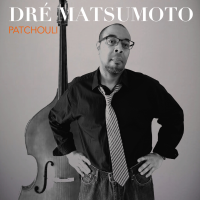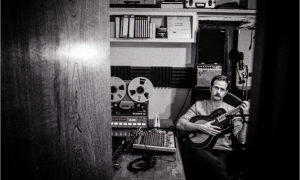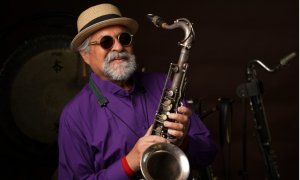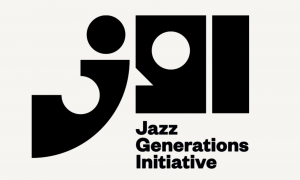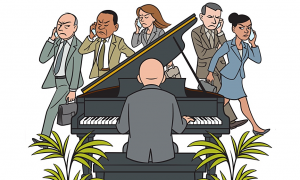In Miles Davis, George found jazz's first superstar. In addition to being enormously talented, Miles was charismatic and intense, with a natural cool. In the new album-cover, TV-show and glossy-magazine age, a visual image mattered--or at least played a big role in winning over fans on a mass scale. In this regard, it's no coincidence that Davis' rise in 1956 coincides with Elvis Presley's. Of course, these artists appealed to different audiences. But Davis was being positioned similarly--new, fresh, individualistic, confident, vulnerable and deeply passionate. Davis, like Elvis, had “it"--and people couldn't take their eyes off of him.
In Part 4 of my five-part series with George, the master producer talks about his club strategy for Davis, the formation of Davis' first quintet, George's formula for sequencing the tracks on 'Round About Midnight, and the inspiration for Miles Ahead:
JazzWax: When you were thinking about signing Miles Davis in 1955, you faced a challenge.
George Avakian: Yes. He had soured owners by not showing up. They viewed him as a high risk.
JW: What did you do?
GA: I was pretty friendly with Jack Whittemore of Shaw Artists Corp., the second or third largest booking agency for jazz musicians.
JW: What did you say?
GA: I said, “Jack, if I sign Miles, he promises to keep the same group together and to keep it going if you can keep on booking him, despite the obstacles you've encountered in the past." I said, “At the end of the year, when publicity builds in support of his first album ['Round About Midnight], I promise it's going to be big because I plan to spend a lot of money to establish Miles Davis." [Photo of Miles Davis by Don Hunstein]
JW: What did Whittemore say?
GA: Jack agreed and Miles agreed. Within a few days in 1955, Miles had a lineup of musicians ready for touring. Sonny Rollins was on tenor saxophone, which was great because I had become very friendly with Sonny and had already tried to record him.
JW: What happened?
GA: Sonny was still under contract to another label. Then disaster struck when Sonny quit Miles' group. He got an offer from a Chicago club to play with a local rhythm section for four times the money that he could make with Miles. He also liked the idea that he'd be based in Chicago and wouldn't have to tour. He had already kicked his habit. [Photo of Sonny Rollins by Francis Wolff]
JW: Who did Miles use in his place?
GA: Cannonball Adderley. But then Cannonball quit, too. He had been teaching in the Florida school system and had tenure. He said, “I can be more assured of my future if I keep my tenure as a teacher than traveling as a jazz musician." He went in that direction.
JW: So what did Miles do?
GA: Miles called in the early fall of 1955 and said he had a new saxophonist for the quintet. It was John Coltrane. I had heard Coltrane at the open mike sessions at Birdland. He was just one of several young musicians there, but at the time he didn't make a huge impression on me. When Miles hired John, we made this plan: Miles asked me to come down to Philadelphia and listen to the new group. He said, “If you like it, I have a booking at the Cafe Bohemia in New York and we can record us then." [Photo of John Coltrane by Francis Wolff]
JW: What did you think?
GA: Well I certainly did like it because on the third set, Coltrane played a long up-tempo solo that knocked me out. This was the fall of 1955, when we got started recording 'Round About Midnight.
JW: You had a secret formula for 'Round About Midnight, didn't you?
GA: Well, it wasn't so secret. It was an overall concept I had in mind when Columbia switched to the 12-inch LP. The switch to the larger disc size for pop and jazz came when I was able to lower manufacturing costs, which made the two-cent royalty fee easier to absorb and still earn a profit. But on the longer records, I realized albums had to be programmed carefully.
JW: What did you do?
GA: I wanted the first track to make listeners glad they bought the album. The last track on the first side was designed to make the person turn the record over. The last track on the second side had to send listeners back to the store to say, “Hey, Mr. Dealer, I want another by this guy. What have you got?"
JW: In essence, you were treating an LP like a Broadway show.
GA: A 12-inch LP no longer could be simply a collection of singles. It was a journey, with a start and a finish. People put it on and sat down expecting a performance, a range of moods, a sequence.
JW: What did you think of 'Round About Midnight?
GA: I thought it was great. We recorded that in late 1955 and the spring of 1956, in between the Prestige recording schedule and Miles' tour dates. But my mind was already thinking about Davis' next album. Record-buyers think in terms of individual albums. Producers think in terms of building an artist's body of work.
JW: What were you thinking while 'Round About Midnight was being recorded?
GA: I was already thinking about what I was going to do for an even bigger follow-up. That's how the idea for Miles Ahead: Miles Davis + 19 with Gil Evans came about. I wanted to do something different that would establish Miles as a soloist and frame him in an orchestral setting. By the time we had the first album with the quintet completed, the second album, with Gil Evans, was already underway.
JW: What was the inspiration for that concept?
GA: It came from what Gunther Schuller and John Lewis had put together in 1956 for their Jazz-Classical Music Society.
JW: How did Davis tie in?
GA: The Jazz-Classical Music Society had a concert schedule all rehearsed but it had to be canceled. The key piece was a work by Gunther Schuller for brass and percussion. But when Dimitri Mitropoulos [pictured], conductor of the New York Philharmonic, saw the score, he told Gunther that he wanted to do it with the Philharmonic. Well, you can't perform an original piece that the Philharmonic is going to do at the same time. You're trying to attract the same audience. So the Jazz-Classical Music Society's concert was canceled.
JW: Did Davis hear it?
GA: The group also had jazz pieces that were written and arranged by J.J. Johnson and John Lewis, and included parts for trumpet and flugelhorn. We were going to record the music. John and J.J. asked me if I thought Miles would be willing to record with them, since he was signed to Columbia. So I asked Miles and he accepted enthusiastically. I also invited Miles to hear Dimitri Mitropoulos conduct one of Gunther's compositions with members of the Philharmonic for the recording. When Miles asked me in the studio if he could play with Dimitri's group, I asked the conductor during a break. [Photo of Miles Davis by Don Hunstein]
Tomorrow, George talks about Dimitri Mitropoulos' response to his question, George's role in helping Miles shape the visual image of his group, and the Gil Evans album that never was recorded but led to Sketches of Spain.
JazzWax tracks: To hear the inspiration for Miles Ahead: Miles Davis + 19, you have to listen to The Birth of the Third Stream, which originally was entitled Music for Brass. Miles was featured on Three Little Feelings and Poem for Brass. Unfortunately, Birth of the Third Stream is out of print and is available here for a small fortune. With any luck, Sony will re-issue it as a download.
This story appears courtesy of JazzWax by Marc Myers.
Copyright © 2025. All rights reserved.






